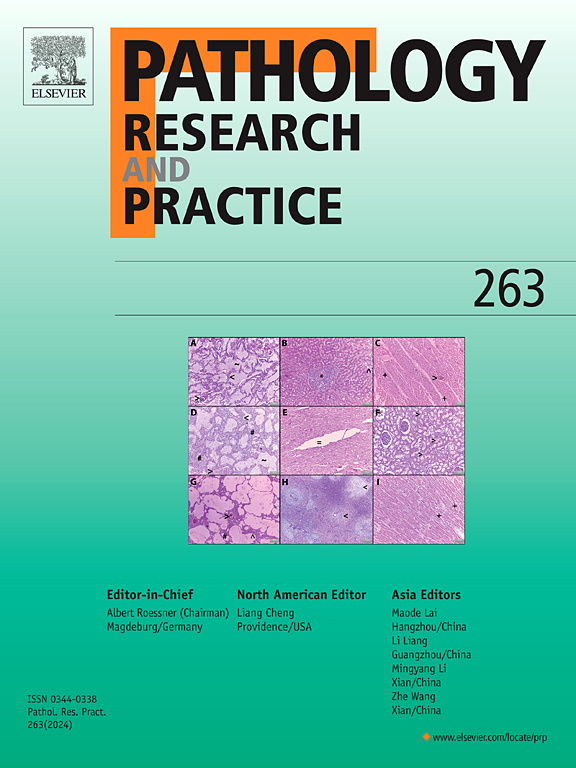肽基脯氨酸异构酶PIN1作为癌症进展和治疗的关键调节因子。
IF 3.2
4区 医学
Q2 PATHOLOGY
引用次数: 0
摘要
PIN1是一种独特的磷酸化依赖性肽酰脯氨酸顺式反式异构酶,通过催化Ser/Thr-Pro基序磷酸化蛋白的构象变化,在致癌信号传导中起关键调节作用。它在多种癌症中的过表达通过同时灭活肿瘤抑制因子和激活癌基因来驱动肿瘤发生,从而促进不受控制的增殖、细胞凋亡逃避、基因组不稳定、上皮-间质转化(EMT)、转移和治疗耐药性。PIN1通过与关键通路(包括PI3K/Akt/mTOR、Wnt/β-catenin、NF-κB和DNA修复机制)的相互作用,对多种癌症标志进行关键调控。在临床上,PIN1过表达与疾病晚期、预后不良和治疗失败相关,强调了其作为预后生物标志物的价值。最近在pin1靶向治疗方面的突破显示出巨大的希望。本综述旨在解释PIN1在癌症中的致癌作用和治疗靶点。直接抑制剂和重新使用的药物破坏癌蛋白的稳定性,诱导“BRCAness”使肿瘤对PARP抑制剂敏感,并逆转化疗耐药。新的策略,包括基于肽的抑制剂和天然化合物,在临床前模型中显示出更高的选择性和有效性。然而,挑战仍然存在,包括pin1驱动机制的癌症类型异质性,靶毒性风险以及对生物可利用抑制剂的需求。未来的研究必须优先描述共同的核心途径、结构引导的药物设计和生物标志物驱动的联合疗法。抑制PIN1是克服耐药性和改善恶性肿瘤预后的一种变革性方法。本文章由计算机程序翻译,如有差异,请以英文原文为准。
Peptidyl-prolyl isomerase PIN1 as a pivotal regulator of cancer progression and therapy
PIN1, a unique phosphorylation-dependent peptidyl-prolyl cis-trans isomerase, serves as a pivotal regulator of oncogenic signaling by catalyzing conformational changes in proteins phosphorylated at Ser/Thr-Pro motifs. Its overexpression across diverse cancers drives tumorigenesis by simultaneously inactivating tumor suppressors and activating oncogenes, thereby promoting uncontrolled proliferation, apoptosis evasion, genomic instability, epithelial-mesenchymal transition (EMT), metastasis, and therapy resistance. PIN1 critically regulates multiple cancer hallmarks via interactions with key pathways, including PI3K/Akt/mTOR, Wnt/β-catenin, NF-κB, and DNA repair machinery. Clinically, PIN1 overexpression correlates with advanced disease stage, poor prognosis, and therapeutic failure, underscoring its value as a prognostic biomarker. Recent breakthroughs in PIN1-targeted therapies demonstrate significant promise. This review aimed to explain PIN1's oncogenic roles and therapeutic targeting in cancer. Direct inhibitors and repurposed agents destabilize oncoproteins, induce "BRCAness" to sensitize tumors to PARP inhibitors, and reverse chemoresistance. Novel strategies, including peptide-based inhibitors and natural compounds, show enhanced selectivity and efficacy in preclinical models. However, challenges persist, including cancer-type heterogeneity in PIN1-driven mechanisms, on-target toxicity risks, and the need for bioavailable inhibitors. Future research must prioritize delineating common core pathways, structure-guided drug design, and biomarker-driven combination therapies. PIN1 inhibition represents a transformative approach to overcome resistance and improve outcomes across malignancies.
求助全文
通过发布文献求助,成功后即可免费获取论文全文。
去求助
来源期刊
CiteScore
5.00
自引率
3.60%
发文量
405
审稿时长
24 days
期刊介绍:
Pathology, Research and Practice provides accessible coverage of the most recent developments across the entire field of pathology: Reviews focus on recent progress in pathology, while Comments look at interesting current problems and at hypotheses for future developments in pathology. Original Papers present novel findings on all aspects of general, anatomic and molecular pathology. Rapid Communications inform readers on preliminary findings that may be relevant for further studies and need to be communicated quickly. Teaching Cases look at new aspects or special diagnostic problems of diseases and at case reports relevant for the pathologist''s practice.

 求助内容:
求助内容: 应助结果提醒方式:
应助结果提醒方式:


